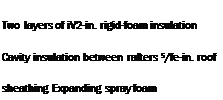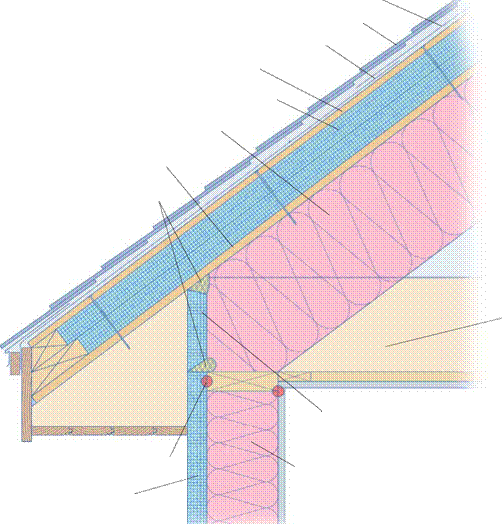Using Rigid Foam for an Efficient and Dry House
■ BY MARTIN HOLLADAY
|
R |
emodelers who open up fiberglass – insulated walls in the middle of the winter are often surprised to see a thin layer of frost on the interior side of the wall sheathing. The frost indicates that warm, humid interior air is leaking through the wall penetrations, leading to condensation on the cold surface of the sheathing.
One way to limit this phenomenon is to keep the sheathing warm by adding a layer of rigid-foam insulation on the exterior side of the sheathing. If there are no cold surfaces in the wall cavities, condensation is unlikely. A layer of exterior foam also makes a house more energy efficient by increasing insulating performance, reducing thermal bridging, and minimizing air leakage.
All three types of rigid-foam insulation— expanded polystyrene (EPS), extruded polystyrene (XPS), and polyisocyanurate—are suitable for use on the exterior of walls and
roofs, though they do not perform equally. EPS is the most vapor permeable of the three types; at R-4, it also has the lowest R-value per inch. Foil-faced polyiso is the least vapor permeable and has the highest R-value per inch, at R-6.5. XPS (R-5 per in.) and the denser types of EPS can extend below grade, but polyiso absorbs water and therefore should not be installed in contact with soil.
Every wall needs a water-resistive barrier such as asphalt felt or housewrap. It’s also possible to use rigid foam as a barrier, as long as foam seams are sealed with a suitable tape or installed with Z-flashing. Regardless of your choice of barrier, all penetrations, including windows and doors, need to be flashed properly; these flashings need to be integrated with the barrier using adequate overlaps or durable tapes.


![]()
![]()


![]()
![]()
 The benefits of adding a layer of rigid-foam insulation to the exterior of walls and roofs are twofold. First, the foam will increase thermal performance by adding R-value and minimizing thermal bridging. Second, the foam will keep the sheathing warm, so moisture passing through the wall or roof will find no cold surfaces for condensation to occur. For this reason, the roof does not need to be vented. That’s why exterior roof foam makes a lot of sense on difficult-to-vent hipped roofs or on roofs with multiple dormers.
The benefits of adding a layer of rigid-foam insulation to the exterior of walls and roofs are twofold. First, the foam will increase thermal performance by adding R-value and minimizing thermal bridging. Second, the foam will keep the sheathing warm, so moisture passing through the wall or roof will find no cold surfaces for condensation to occur. For this reason, the roof does not need to be vented. That’s why exterior roof foam makes a lot of sense on difficult-to-vent hipped roofs or on roofs with multiple dormers.






Leave a reply